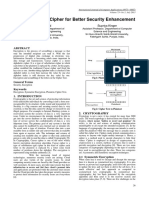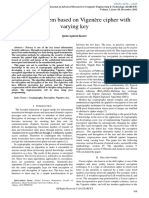0% found this document useful (0 votes)
132 views6 pagesLecture-07-Caesar Cipher
The document discusses the Caesar cipher technique, which is the simplest and oldest method of cryptography. It involves shifting all letters of the plaintext by a set number of positions. For example, shifting each letter by 1 would change A to B, B to C, and so on. While easy to implement, the Caesar cipher provides very little security since it can be easily hacked by analyzing letter patterns or trying all possible shift amounts. The document also defines plaintext as the original message and ciphertext as the encrypted message.
Uploaded by
Usman AziZCopyright
© © All Rights Reserved
We take content rights seriously. If you suspect this is your content, claim it here.
Available Formats
Download as DOCX, PDF, TXT or read online on Scribd
0% found this document useful (0 votes)
132 views6 pagesLecture-07-Caesar Cipher
The document discusses the Caesar cipher technique, which is the simplest and oldest method of cryptography. It involves shifting all letters of the plaintext by a set number of positions. For example, shifting each letter by 1 would change A to B, B to C, and so on. While easy to implement, the Caesar cipher provides very little security since it can be easily hacked by analyzing letter patterns or trying all possible shift amounts. The document also defines plaintext as the original message and ciphertext as the encrypted message.
Uploaded by
Usman AziZCopyright
© © All Rights Reserved
We take content rights seriously. If you suspect this is your content, claim it here.
Available Formats
Download as DOCX, PDF, TXT or read online on Scribd
/ 6

































































































